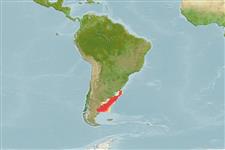>
Pleuronectiformes (Flatfishes) >
Paralichthyidae (Large-tooth flounders)
Etymology: Paralichthys: Greek, para = the side of + Greek, ichthys = fish + Greek, suffix, oides = similar to (Ref. 45335).
More on author: Jordan.
Environment: milieu / climate zone / depth range / distribution range
Ecologia
marinhas demersal; intervalo de profundidade 50 - 190 m (Ref. 36453), usually 70 - 100 m (Ref. 43588). Subtropical; 34°S - 47°S
Southwest Atlantic: Brazil to Argentina.
Tamanho / Peso / Idade
Maturity: Lm ? range ? - ? cm
Max length : 32.0 cm TL macho/indeterminado; (Ref. 43588); 38.0 cm TL (female); peso máx. Publicado: 456.14 g (Ref. 102462)
Descrição breve
Morfologia | Morfometria
Espinhos dorsais (total): 0; Raios dorsais moles (total): 79-92; Espinhos anais 0; Raios anais moles: 65 - 72; Vértebras: 38 - 39. Caudal fin double truncate (Ref. 27363). Almost wholly ambicolorate, the blind side is darkly pigmented except for the anterior portion of the body which has dark pigments only on the opercle, subopercle, a small region adjacent and dorsal to the head, and the distal half of the pectoral fin; two lighter pigmented areas were present on the unpigmented dorsal region of the head. The blind side had one of the 3 typical ocelli (upper one) in the same position with that of the ocular side (Ref. 34245).
Prefers hard or sandy substrates, rarely on mud (Ref. 43588). Feeds on fishes and cephalopods (Ref. 36453).
Life cycle and mating behavior
Maturidade | Reprodução | Desova | Ovos | Fecundidade | Larvas
Distinct pairing (Ref. 205).
Nakamura, I., T. Inada, M. Takeda and H. Hatanaka, 1986. Important fishes trawled off Patagonia. Japan Marine Fishery Resource Research Center, Tokyo. 369 p. (Ref. 27363)
Categoria na Lista Vermelha da IUCN (Ref. 130435)
Ameaça para o homem
Harmless
Utilização humana
Mais informação
ReferênciasAquaculturaPerfil para aquaculturaEstirpesGenéticaElectrophoresesHereditariedadeDoençasProcessamentoNutrientsMass conversion
ColaboradoresFotografiasStamps, Coins Misc.SonsCiguateraVelocidadeTipo de nataçãoÁrea branquialOutras referênciasCérebrosVisão
Ferramentas
Relatórios especiais
Descarregue XML
Fontes da internet
Estimates based on models
Preferred temperature (Ref.
123201): 4.6 - 10.1, mean 7.9 °C (based on 82 cells).
Phylogenetic diversity index (Ref.
82804): PD
50 = 0.5000 [Uniqueness, from 0.5 = low to 2.0 = high].
Bayesian length-weight: a=0.00479 (0.00270 - 0.00849), b=3.19 (3.04 - 3.34), in cm total length, based on LWR estimates for this species & Genus-body shape (Ref.
93245).
Nível Trófico (Ref.
69278): 4.0 ±0.53 se; based on food items.
Resiliência (Ref.
120179): Elevada, tempo mínimo de duplicação da população menor que 15 meses (Preliminary K or Fecundity.).
Fishing Vulnerability (Ref.
59153): Low to moderate vulnerability (28 of 100).
